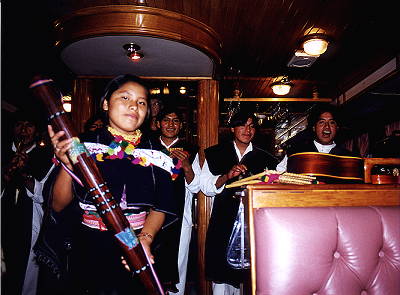

Thanks to my guidebook, I'm well informed that the best side to sit in the plane ride from Quito to the Galápagos is the left. My research is rewarded by a remarkable aerial view of the Andes. The city gives way to mountains, where the farming plots are evident. Soon, the geometric shapes fade away, and the mountains are green with forests. The Andes yield to the clouds, and I sit back and relax for the remainder of the short flight.
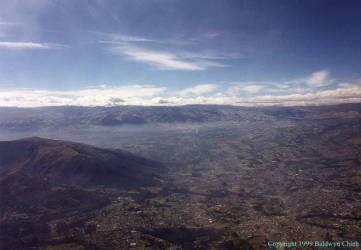 Quito from the airplane |
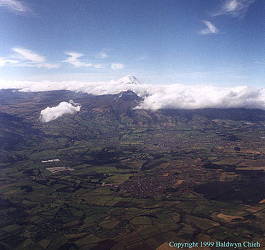 Cotapaxi from the airplane |
After a short layover in Guayaquil, we reach San Cristóbal Island. The airport itself seems to have the Galápagos flavour. It has a roof, and walls to divide areas, but nothing to enclose it from the elements. It resembles more a National Park structure, with it's log construction. We meet our guides Renato, and Javier for the first time, as well as the rest of our tour group. A dingy, or panga is waiting for us at the docks, and soon we head to our home for the next week, the Flamingo I.

Javier briefs us on procedures as the boat pulls up anchor, and heads towards Kicker Rock. We learn the difference between dry-landings and wet-landings, the definition of "good shoes", and how to say "booby" without getting slapped. The service aboard the Flamingo I was outstanding. All our meals were expertly prepared, even in choppy waters. Our bartender, Pablo, was always there to greet us with a smile and a tray of snacks as we climbed aboard from each of our excursions. The panga drivers guided us deftly through our rides, making sure to slow down, stop, and even circle the area when there was something interesting to see.
Our guides, Renato and Javier, became our friends. They were quick at spotting things of interest, and always entertained us as they presented information to us. Both were born on the Islands, and were extremely passionate about conservation of the Galápagos.
Soon we reach Kicker Rock, also known as Sleeping Lion, a tuff formation made from falling volcanic ash. We circle the formation, watching for birds, like frigates, boobies, swallow-tailed gulls, audabon shearwaters, and red-billed tropic birds.

|
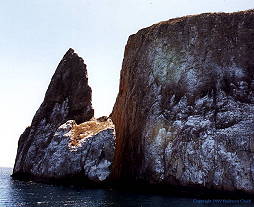
|
After seeing Kicker Rock, the Flamingo heads along the coast to Ochoa Beach, where we make our first landing. Here, I learn to snorkel! It's much easier than I thought, and for the first time, I can see underwater, since contact lenses can be worn with the mask. I glide through the water, looking at the urchins and fish, when I sense something beside me. At first I think it's another snorkeller but it turns out to be a young sea lion, that passes me at arm's length. I head ashore, where Renato talks about the subspecies of Californian sea lions that are endemic to the islands. Just in the last year or so, the sea lions have developed a new diving technique because food sources have been scarce due to El Nino. The sea lions have been seen to swallow large, round rocks to serve as a weight belt, so they can dive deeper and extend their range. After eating their fill, they return to shore, and regurgitate the rocks!
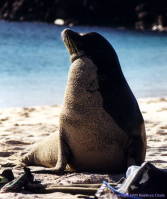
|
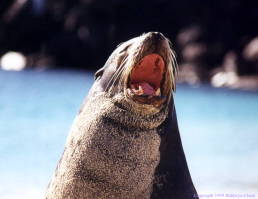
|
As we return to our snorkelling equipment on the beach, we find a large beachmaster patrolling the area. These beachmasters are large sea lion bulls that defend their territory and harem of female sea lions. The other male sea lions establish their own bachelor colony elsewhere, having to fight if they want their own territory or harem. I sit cautiously away from him to snap his picture, but he soon sees the threat of another dominant male, and charges me. I back off, naturally not out of cowardice, but what the heck do I want with a harem of sea lions?
Our first day on the islands is one of promise. We have seen some of the volcanic nature of the archipelago in Kicker Rock, as well as a sample of the legendary bird life. We have our first snorkelling experience, and even manage to get close to some of the wildlife!
The day draws to a close, and we're treated by an onboard performance by a troup of Ecuadorian musicians. The music is rhythmic, and upbeat, with guitars and drums laying the base, and the melody carried by pan flutes and singing.
